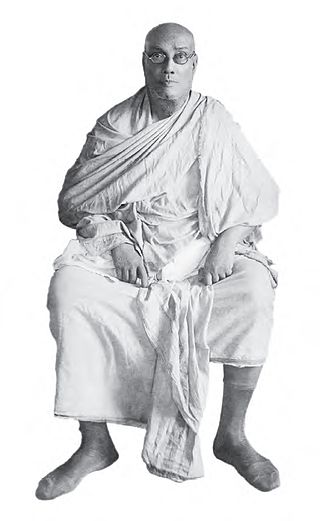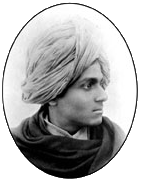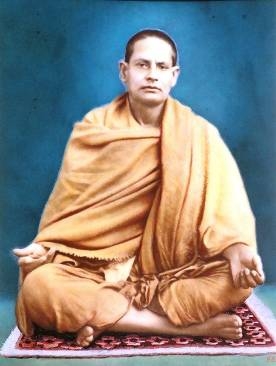
Swami Shivananda (1854–1934), born Tarak Nath Ghosal, was a Hindu spiritual leader and a direct disciple of Ramakrishna, who became the second president of the Ramakrishna Mission. His devotees refer to him as Mahapurush Maharaj. Shivananda and Subodhananda were the only direct disciples of Ramakrishna to be filmed. He was a Brahmajnani. Shivananda introduced the celebration of the birthdays of his brother-monks. He was known to have laid the foundation stone of Shri Ramakrishna Temple at Belur Math, which was designed by Vijnanananda.

Swami Vijnanananda was an Indian monk of Ramakrishna order, born in an upper-class family near Dakshineswar, and was a direct disciple of Ramakrishna. He was an engineer and worked as the District Engineer in the erstwhile State of United Provinces, India. He was a great scholar of Sanskrit with expertise in religio-philosophical works, astronomy, civil engineering etc. He spent considerable time in Allahabad (Prayag) centre of Ramakrishna Math. He became the President of Ramakrishna Mission in 1937. It was under his presidency and direct supervision that the Ramakrishna Temple at Belur Math was constructed and consecrated.

Swami Yatiswarananda was a vice-president of Ramakrishna Order, whose headquarter is in Belur Math. He was a disciple of Swami Brahmananda, a brother disciple of Swami Vivekananda and a direct disciple and spiritual son of Ramakrishna. He served in Philadelphia propagating the message of Vedanta. He was the president of Bangalore centre of Ramakrishna Math. He founded an ashrama in Switzerland.

Shuddhananda who was the fifth president of the Ramakrishna Order, was a direct monastic disciple of Vivekananda. He joined the Ramakrishna Math in 1897. He became a trustee of Ramakrishna Math and a member of the governing body of Ramakrishna Mission in May 1903. He also took up the editorship of the Bengali magazine called Udbodhan for sometime. He was appointed as the secretary of the math and the mission in 1927 and as the vice president in 1937. In 1938, he became the president of the order. His tenure was short, as he died in 1938. He is renowned in the literary circles to have translated most of Vivekananda's original works from English to Bengali.

Swami Virajananda, born Kalikrishna Bose, was an initiated disciple of Sarada Devi and the sixth president of the Ramakrishna Order. Born as the son of Trailokyanath Bose and Nishadkalidevi, Virajananda was the first person to join the Ramakrishna Order after the direct disciples of Ramakrishna. In 1897, he was initiated into sannyasa by Vivekananda. From 1899 onward he served in Advaita Ashrama, Mayavati and became its president in 1906. He is recognised as a monastic disciple of Vivekananda.

Ramakrishna Paramhansa Deva had sixteen direct disciples who became monks of the Ramakrishna Order; they are often considered his apostles. In the Ramakrishna-Vivekananda movement, the apostles have played an important role. Apart from Swami Vivekananda, the direct disciples or apostles of Ramakrishna were as follows.

Advaita Ashrama, Mayavati, is a branch of the Ramakrishna Math, founded on 19 March 1899 at the behest of Vivekananda, by his disciples James Henry Sevier, and Charlotte Sevier. Today it publishes the original writings of Vivekananda. As an ashram dedicated to the study and practice of Advaita Vedanta, no images or idols are worshipped there, not even of Ramakrishna; and no images were kept in the premises according to the Ashram ideals set by Vivekananda.

Swarupananda was a direct monastic disciple of Vivekananda and the first president of the Advaita Ashrama, set up by Vivekananda in 1899 at Mayavati, near Champawat. The ashram is a branch of the religious monastic order, Ramakrishna Math, also set up by Vivekananda on the teachings of his guru Ramakrishna.

Baburam Maharaj (Swami Premananda) (Bengali: বাবুরাম মহারাজ; 10 December 1861 – 30 July 1918) was a direct disciple of Ramakrishna, the 19th-century saint and mystic from Bengal, India. He was born in Antpur in the Hoogly district of Bengal in the year 1861. Baburam, as he was called in his pre monastic days, was also related to Balaram Bose, a leading householder disciple of Ramakrishna. He was given the name of Premananda or "joy of divine love" by his brother disciple Vivekananda. He had a notable contribution during the initial days of Ramakrishna Mission as he managed the whole affairs of Belur Math from 1902 to 1916. He also mentored young spiritual aspirants.

Swami Yogananda was a disciple of Ramakrishna, the 19th-century mystic. He took his formal initiation from Sarada Devi, the "holy mother" of Ramakrishna Order and spiritual consort of Ramakrishna. He was the first vice-president of Ramakrishna Mission. He belonged to the family of Sabarna Roy Choudhury, an aristocratic family of erstwhile Bengal. He had a very short life, but he played a very important role during the formative years of Ramakrishna Mission. He was also a dedicated and devoted attendant to Sarada Devi during her stay in Calcutta after Ramakrishna's death. He was one of the disciples whom Ramakrishna referred to as "Iswarakoti" or the "ever perfect soul".

Ramakrishna Math and Mission, Bhubaneswar is a monastic organization for men brought into existence by Ramakrishna (1836–1886), a 19th-century saint of Bengal. The motto of the Ramakrishna Math and Ramakrishna Mission is: "For one's own salvation, and for the welfare of the world". Sri Ramakrishna Math, Bhubaneswar is the first branch center of the Ramakrishna Order in Odisha. It was started in the year 1919 by Swami Brahmananda, one of the direct disciples of Ramakrishna. Besides Swami Brahmananda, the Math was visited by Swami Shivananda, Swami Premananda, Swami Niranjanananda, and Swami Vijnanananda.

Kalyanananda (1874–1937) was a direct monastic disciple of Vivekananda, who had set up the Ramakrishna Mission Sevashrama at Kankhal, near Haridwar. As a monk of the Ramakrishna Order, he took up service to the humanity as the most important philosophy in his life and practiced it for the benefit of the local population and the pilgrims. He spent thirty six-years in Ramakrishna Mission Sevashrama Kankhal to serve the poor and afflicted. He was one of the pioneers to set up a hospital in a remote location for the poor, needy and the itinerant monks who did not have access to healthcare.

Ramakrishna Mission Sevashrama is a branch of Ramakrishna Math and Ramakrishna Mission involved in providing humanitarian, healthcare, education and relief services to poor and needy through the universal principle of serving "God in man", based on the motto, Atmano Moksartham Jagat Hitaya Cha, which was propounded by Swami Vivekananda.

Ramakrishna Mission Sevashrama, Kankhal (RKMS) is in its present form is a 210-bed multi-specialty charitable hospital in Kankhal, Haridwar in Uttarakhand. It is a branch of Ramakrishna Mission, and was established in 1901 by Swami Kalyanananda, one of the direct monastic disciples of Swami Vivekananda. The hospital serves the treatment needs of poor patients in and around Uttarakhand. Since its inception it has treated more than 10 million patients. From a modest beginning in a rented two room dilapidated building it has grown to be a multi-specialty hospital for treatment of impoverished and needy people, under the supervision of the monks of Ramakrishna Order. The hospital is located in an 18 acres campus, and houses Gynecology and Obstetrics, Pediatrics, Intensive Care Units, Pathological laboratory, Blood bank, Operation Theaters etc. in addition to dairy and agricultural land whose products are used for the consumption of poor in patients.

Nischayananda was an Indian monk who worked to help the poor and needy. He was a direct monastic disciple of Vivekananda. He, together with Kalyanananda was responsible for setting up and running the Ramakrishna Mission Sevashrama, Kankhal. He was inspired by Vivekananda's philosophy of serving man as God and dedicated his life to serve poor and downtrodden in the remote areas where no healthcare facility existed. He worked in military service before joining the Ramakrishna Order as a direct monastic disciple of Vivekananda. He met Vivekananda in Madras and decided to become his disciple. After Vivekananda's death, he went for pilgrimage and by chance came to Haridwar where he met his brother disciple Kalyanananda and joined him in carrying out the works of Ramakrishna Mission Sevashrama Kankhal.

Dhanraj Giri (1811–1901) was the abbot of Kailash Ashram, an ashram, which he established in 1880 at Muni Ki Reti, Rishikesh. It was one of the first large ashrams to be established in Rishikesh, prior to which it was mostly as a place for individual seekers, or pilgrims to stop over on way to Char Dham temples pilgrimage. He was a famous monk in Northern India and was a scholar in Vedanta philosophy. He was well acquainted with spiritual luminaries of nineteenth century India like Swami Vivekananda.

Achalananda, popularly known as Kedar Baba, was a direct monastic disciple of Vivekananda and the founder of Ramakrishna Mission Home of Service, in Varanasi. He initially worked as a policeman, but was then influenced by the ideology of Vivekananda.

Swami Prakashananda (1874–1927) was a monastic disciple of Vivekananda and a monk of the Ramakrishna Order who played a major role in propagating and promoting the Vedanta philosophy and Vivekananda's message in India and America. He came to the US in 1906 to serve under Trigunatitananda, a direct disciple of Ramakrishna at the Vedanta Society of San Francisco, later renamed as Vedanta Society of Northern California, and later became its president.
Vimalananda (1872–1908) was an Indian spiritual writer who was one of the monastic disciples of Vivekananda and an early monk of the Ramakrishna Order. He was involved in the publication of Prabuddha Bharata. He was actively involved in running day-to-day operations of the Advaita Ashrama at Mayavati during the early days of the Ashrama. He also inaugurated the Ramakrishna Math at Ulsoor in Bangalore in 1906. He died in 1908 at the Mayavati Ashrama.

Ramakrishna Mission Sevashrama Sargachi is located in Murshidabad district of West Bengal. It was founded by Swami Akhandananda, a direct disciple of Sri Ramakrishna in August, 1897. It is a spiritual and philanthropic centre under Belur Math, the headquarters of Ramakrishna Order. It started with an orphanage and later undertook many activities in the fields of education, treatment of poor, training and development, agriculture and overall development of a very poor and backward area of West Bengal. All of these activities are undertaken as spiritual practices.



















